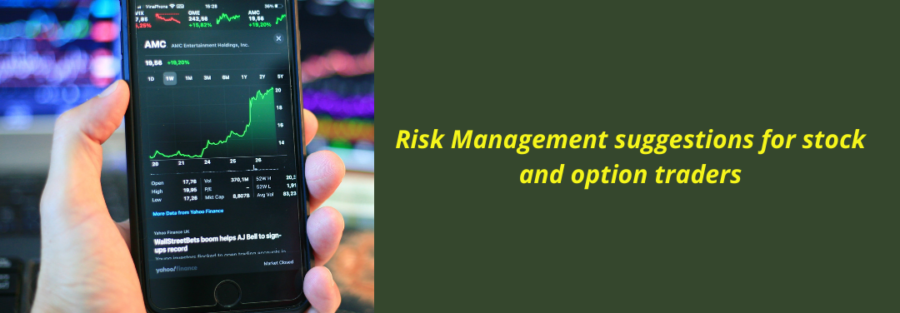Risk Management Suggestions For Stocks and Options Trader
Its important that you define the trading plan before entering any trade.
A trading plan includes the following:
- Risk to Reward ratio.
- Time frame of trade.
- Trade size.
Trading in stocks:
Assume you have a minimum risk to reward ratio of 1:1
Scenario 1- If you buy entire quantity in 1 single trade.
- If you keep 5% of the investment amount in a trade as stop loss, then your target on upside should be at around 5%.
- If the stock has gained 5% and is still looking bullish, then you can keep the trade running with your first target as the stop loss.
Scenario 2 – Buying stocks at multiple price levels when stock is going up/down after the purchase.
Assume you make a 50% investment in a particular stock at a certain price with the possibility of it going up/down after the purchase, then –
- Treat the first investment you make in such stock as trade done at an average cost of both the trades and keep your stop loss and targets in 1:1 ratio from the average cost.
- If your initial stop loss is at 5% of the average cost, then your target on upside should be at around 5% of the average cost.
- If the stock has gained 5% and is still looking bullish, then you can keep the trade running with your first target as the stop loss. However, if your first target is lower than the cost price of the first purchase then keep the trailing stop loss above the cost price of first trade.
Note -
- Make sure, you never buy stocks whose risk to reward ratio is lower than 1:1 when you are trading it in a single buy.
- Do not lose the profits for additional upside.
- If you do a covered call, then the premiums gained over the timeframe can be adjusted to the cost of your investment.
Trading in options:
You can set different risk to reward ratios based on the strategies you apply for options trading. Avoid trades that do not fit the minimum risk to reward ratio you decide for yourself.
Trading on a naked buy option – You can trade with a risk to reward ratio of 1:2 or higher.
Trading on a debit spread – You can trade with a risk to reward ratio of 1:2 or higher.
Trading on a credit spread – You can trade with a risk to reward ratio of 1:1 or higher.
Note -
Higher the risk you take, higher will be the box size between sell Call/Put and buy Call/Put and higher will be the profit.
Based on above Risk Structure, you can follow the below trading practice –
- Keep 40% of funds for stocks.
- Keep 10% of funds for naked options.
- Keep 25% of funds for debit spreads.
- Keep 25% of funds for credit spreads.
Assuming you see opportunities in market that would favor the naked options traders and want to use more funds in your account towards these. We would suggest you to avoid allocating more funds and break the above risk structure, unless you think the market would continue to put similar opportunities in front of you for next 2-3 months. In this case, you can revise your risk structure.


